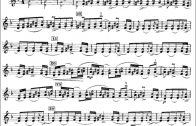The Best of Bartók
The Best of Béla Viktor János Bartók (March 25, 1881 – September 26, 1945)
Bartók is considered one of the most important composers of the 20th century; he and Liszt are often regarded as Hungary’s greatest composers. Through his collection and analytical study of folk music, he was one of the founders of comparative musicology, which later became ethnomusicology.
Life and Music:
* Béla Bartók was an infant prodigy.
* He was performing on the piano in public by the age of 11 and by the time he had graduated from the Budapest Royal Academy in 1903 he was confidently composing in the Liszt-Richard Strauss mould.
* Bartok formed a partnership with the composer Zoltan Kodaly and together they set about collecting Hungarian and Transylvanian folk songs. This formed the bedrock of Bartok’s fast developing musical style.
* During the decade between the late 1920s and 1930s the seemingly conflicting musical elements were fused, resulting in a stream of masterpieces, from the breathtaking rhythmic propulsion and ear-tweaking sonorities of the Sonata for Two Pianos and Percussion (1937) to the post-Romantic luxuriance of the Second Violin Concerto (1937).
* Bartok escaped the horrors of war for New York, which brought with it a change of style.
* He composed little for two years until a commission from the conductor Serge Koussevitzky opened the floodgates once more. This released works such as the Concerto for Orchestra, the Third Piano Concerto and the sadly incomplete Viola Concerto.
* Bartok had one last surprise up his sleeve, however, with the uncompromising and enigmatic Sonata for Solo Violin (1944), written for Yehudi Menuhin.
Read more at http://www.classicfm.com/composers/bartok/#xYd3iYelFOjxg1sv.99
Music for Strings, Percussion and Celesta:
0:00 I. Andante tranquillo
7:30 II.Allegro
15:09 III. Adagio
22:20 IV. Allegro molto
30:02 The Wooden Prince Suite, Op. 13, Sz. 60
42:43 Divertimento for Strings, II. Molto adagio [Sz 113]
52:03 Dance Suite – Finale
56:12 Bluebeard’s Castle, Megérkeztünk – Íme Lássad [BB 62]
Concerto for Orchestra:
1:05:10 I. Introduzione [BB 123]
1:14:50 II. Gioco delle coppie [BB 123]
1:21:26 III. Elegia [BB 123]
1:28:10 IV. Intermezzo interrotto [BB 123]
1:32:42 V. Finale [BB 123]
Violin Concerto No. 2:
1:42:16 I. Allegro non troppo [BB 117]
1:57:30 II Andante tranquillo [BB 117]
2:06:28 III. Allegro molto [BB 117]
Concerto for Piano and Orchestra No. 2:
2:18:02 I. Allegro [BB 101]
2:27:47 II. Adagio – Presto – Adagio [BB 101]
2:40:38 III. Allegro molto [BB 101]
Concerto for Piano and Orchestra No. 3:
2:47:03 I. Allegretto [BB 127]
2:54:17 II. Adagio religioso [BB 127]
3:03:54 III. Allegro vivace [BB 127]
3:10:18 Piano Sonata: III. Allegro molto [BB 88]
3:13:59 String Quartet No. 2, I. Moderato [BB 75]
3:24:02 String Quartet No. 6, IV. Mesto [BB 119]
Performers:
Music for Strings, Percussion and Celesta- Budapest Symphony Orchestra/György Lehel
The Wooden Prince – Budapest Philharmonic Orchestra/András Kórodi
Divertimento Sz. 113, BB 118 – Hungarian State Orchestra/Antal Doráti
Dance Suite – Finale – Budapest Philharmonic Orchestra/János Sándor
Bluebeard’s Castle – Katalin Kasza (soprano), György Melis (baritone), Hungarian Radio & Television Chorus, Budapest Philharmonic Orchestra/János Ferencsik
Concerto for Orchestra Sz. 116, BB 123 – Hungarian State Orchestra/Antal Doráti
Violin Concerto No. 2 Sz. 112, BB 117 – Dénes Kovács (violin), Budapest Symphony Orchestra/Ervin Lukács
Piano Concerto No. 2 – Zoltán Kocsis (piano), Budapest Symphony Orchestra/György Lehel
Piano Concerto No. 3 – Dezsõ Ránki (piano), Hungarian State Orchestra/János Ferencsik
Piano Sonata – Erzsébet Tusa
String Quartet No. 2 and No. 6 -Tátrai Quartet















